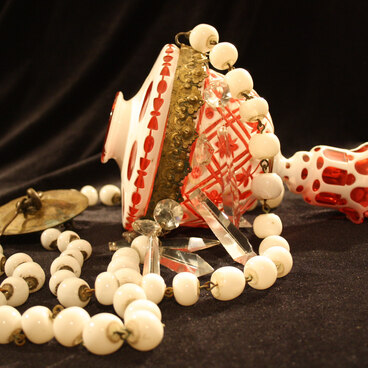The Dyatkovo Crystal Factory was founded by the Maltsovs — the famous industrialists and patrons of art. They also owned a group of other enterprises which, in the 19th century, were located in three governorates: Oryol, Smolensk, and Kaluga. Characterized by a high quality of life and advanced manufacturing processes, this large industrial region was sometimes referred to as “the Russian America”. Remarkably, the Maltsovs considered all newly purchased and constructed enterprises to be parts of a consolidated system where the demands of one element resulted from the demands of another. This extensive industrial complex included glassworks, bottle, sodium, faience, and crystal factories, rail mills, iron foundries, and sugar refineries. The facilities were connected by a private narrow-gauge railroad that combined all the manufacturing processes into a single system.
The region’s heyday is associated with the name of the prominent representative of the dynasty — Sergey Maltsov (1810–1893). Nowadays, “Maltsov glass” and “Maltsov crystal” are familiar terms for anyone who studies the history of Russian decorative and applied art, for all art experts, museum researchers, and collectors. The brand of Maltsov glass factories continues to spark interest both in Russia and beyond and is valued highly at international exhibitions.
The union of Oryol, Smolensk, and Kaluga Governorates is commemorated with this heavy goblet made of colorless glass. The austere composition of the goblet consists of alternating narrow strips and one wide strip — this gives the goblet a certain monumentality. The stable base is surrounded by three relief bands and merges into a wide bell, with its relief part decorated with a small geometric pattern. The base of the upper part is encircled with a band indicating the names of the governorates written using a beautiful ornamental script in Old Slavonic. Above it is a wide area with the images of three coats of arms and crowns above them. The coat of arms of the Oryol governorate depicts a double-headed eagle against a city wall, the Smolensk one features a cannon, and the Kaluga one — a crown. Above the coats of arms is a narrow band with embossed relief rosettes. At the top is a smooth polished area. Massive and ceremonial, the goblet embodies the nature of the Maltsov majestic industrial empire.
The region’s heyday is associated with the name of the prominent representative of the dynasty — Sergey Maltsov (1810–1893). Nowadays, “Maltsov glass” and “Maltsov crystal” are familiar terms for anyone who studies the history of Russian decorative and applied art, for all art experts, museum researchers, and collectors. The brand of Maltsov glass factories continues to spark interest both in Russia and beyond and is valued highly at international exhibitions.
The union of Oryol, Smolensk, and Kaluga Governorates is commemorated with this heavy goblet made of colorless glass. The austere composition of the goblet consists of alternating narrow strips and one wide strip — this gives the goblet a certain monumentality. The stable base is surrounded by three relief bands and merges into a wide bell, with its relief part decorated with a small geometric pattern. The base of the upper part is encircled with a band indicating the names of the governorates written using a beautiful ornamental script in Old Slavonic. Above it is a wide area with the images of three coats of arms and crowns above them. The coat of arms of the Oryol governorate depicts a double-headed eagle against a city wall, the Smolensk one features a cannon, and the Kaluga one — a crown. Above the coats of arms is a narrow band with embossed relief rosettes. At the top is a smooth polished area. Massive and ceremonial, the goblet embodies the nature of the Maltsov majestic industrial empire.


